接前一篇文章:
上回书继续讲解virtio_pci_driver的 probe 回调函数virtio_pci_probe(),在讲到第5段代码的时候,
- if (force_legacy) {
- rc = virtio_pci_legacy_probe(vp_dev);
- /* Also try modern mode if we can't map BAR0 (no IO space). */
- if (rc == -ENODEV || rc == -ENOMEM)
- rc = virtio_pci_modern_probe(vp_dev);
- if (rc)
- goto err_probe;
- } else {
- rc = virtio_pci_modern_probe(vp_dev);
- if (rc == -ENODEV)
- rc = virtio_pci_legacy_probe(vp_dev);
- if (rc)
- goto err_probe;
- }
引出来两个函数:virtio_pci_legacy_probe和virtio_pci_modern_probe。本回就来对它们进行解析。当然,由于legacy已是“过去时”(针对传统设备的),因此重点围绕virtio_pci_modern_probe函数进行解析,捎带手地也讲一下virtio_pci_legacy_probe函数。为了便于理解和回顾,再次贴出两个函数的源码:
- virtio_pci_legacy_probe
virtio_pci_legacy_probe函数在 Linux 内核源码/drivers/ virtio /virtio_pci_legacy.c中,代码如下:
- /* the PCI probing function */
- int virtio_pci_legacy_probe(struct virtio_pci_device *vp_dev)
- {
- struct virtio_pci_legacy_device *ldev = &vp_dev->ldev;
- struct pci_dev *pci_dev = vp_dev->pci_dev;
- int rc;
-
- ldev->pci_dev = pci_dev;
-
- rc = vp_legacy_probe(ldev);
- if (rc)
- return rc;
-
- vp_dev->isr = ldev->isr;
- vp_dev->vdev.id = ldev->id;
-
- vp_dev->vdev.config = &virtio_pci_config_ops;
-
- vp_dev->config_vector = vp_config_vector;
- vp_dev->setup_vq = setup_vq;
- vp_dev->del_vq = del_vq;
-
- return 0;
- }
- virtio_pci_modern_probe
virtio_pci_modern_probe函数在Linux内核源码/drivers/virtio/virtio_pci_modern.c中,代码如下:
- /* the PCI probing function */
- int virtio_pci_modern_probe(struct virtio_pci_device *vp_dev)
- {
- struct virtio_pci_modern_device *mdev = &vp_dev->mdev;
- struct pci_dev *pci_dev = vp_dev->pci_dev;
- int err;
-
- mdev->pci_dev = pci_dev;
-
- err = vp_modern_probe(mdev);
- if (err)
- return err;
-
- if (mdev->device)
- vp_dev->vdev.config = &virtio_pci_config_ops;
- else
- vp_dev->vdev.config = &virtio_pci_config_nodev_ops;
-
- vp_dev->config_vector = vp_config_vector;
- vp_dev->setup_vq = setup_vq;
- vp_dev->del_vq = del_vq;
- vp_dev->isr = mdev->isr;
- vp_dev->vdev.id = mdev->id;
-
- return 0;
- }
virtio_pci_modern_probe函数中最主要地是调用了vp_modern_probe函数,其在Linux内核源码/drivers/virtio/virtio_pci_modern_dev.c中,代码如下:
- /*
- * vp_modern_probe: probe the modern virtio pci device, note that the
- * caller is required to enable PCI device before calling this function.
- * @mdev: the modern virtio-pci device
- *
- * Return 0 on succeed otherwise fail
- */
- int vp_modern_probe(struct virtio_pci_modern_device *mdev)
- {
- struct pci_dev *pci_dev = mdev->pci_dev;
- int err, common, isr, notify, device;
- u32 notify_length;
- u32 notify_offset;
-
- check_offsets();
-
- /* We only own devices >= 0x1000 and <= 0x107f: leave the rest. */
- if (pci_dev->device < 0x1000 || pci_dev->device > 0x107f)
- return -ENODEV;
-
- if (pci_dev->device < 0x1040) {
- /* Transitional devices: use the PCI subsystem device id as
- * virtio device id, same as legacy driver always did.
- */
- mdev->id.device = pci_dev->subsystem_device;
- } else {
- /* Modern devices: simply use PCI device id, but start from 0x1040. */
- mdev->id.device = pci_dev->device - 0x1040;
- }
- mdev->id.vendor = pci_dev->subsystem_vendor;
-
- /* check for a common config: if not, use legacy mode (bar 0). */
- common = virtio_pci_find_capability(pci_dev, VIRTIO_PCI_CAP_COMMON_CFG,
- IORESOURCE_IO | IORESOURCE_MEM,
- &mdev->modern_bars);
- if (!common) {
- dev_info(&pci_dev->dev,
- "virtio_pci: leaving for legacy driver\n");
- return -ENODEV;
- }
-
- /* If common is there, these should be too... */
- isr = virtio_pci_find_capability(pci_dev, VIRTIO_PCI_CAP_ISR_CFG,
- IORESOURCE_IO | IORESOURCE_MEM,
- &mdev->modern_bars);
- notify = virtio_pci_find_capability(pci_dev, VIRTIO_PCI_CAP_NOTIFY_CFG,
- IORESOURCE_IO | IORESOURCE_MEM,
- &mdev->modern_bars);
- if (!isr || !notify) {
- dev_err(&pci_dev->dev,
- "virtio_pci: missing capabilities %i/%i/%i\n",
- common, isr, notify);
- return -EINVAL;
- }
-
- err = dma_set_mask_and_coherent(&pci_dev->dev, DMA_BIT_MASK(64));
- if (err)
- err = dma_set_mask_and_coherent(&pci_dev->dev,
- DMA_BIT_MASK(32));
- if (err)
- dev_warn(&pci_dev->dev, "Failed to enable 64-bit or 32-bit DMA. Trying to continue, but this might not work.\n");
-
- /* Device capability is only mandatory for devices that have
- * device-specific configuration.
- */
- device = virtio_pci_find_capability(pci_dev, VIRTIO_PCI_CAP_DEVICE_CFG,
- IORESOURCE_IO | IORESOURCE_MEM,
- &mdev->modern_bars);
-
- err = pci_request_selected_regions(pci_dev, mdev->modern_bars,
- "virtio-pci-modern");
- if (err)
- return err;
-
- err = -EINVAL;
- mdev->common = vp_modern_map_capability(mdev, common,
- sizeof(struct virtio_pci_common_cfg), 4,
- 0, sizeof(struct virtio_pci_common_cfg),
- NULL, NULL);
- if (!mdev->common)
- goto err_map_common;
- mdev->isr = vp_modern_map_capability(mdev, isr, sizeof(u8), 1,
- 0, 1,
- NULL, NULL);
- if (!mdev->isr)
- goto err_map_isr;
-
- /* Read notify_off_multiplier from config space. */
- pci_read_config_dword(pci_dev,
- notify + offsetof(struct virtio_pci_notify_cap,
- notify_off_multiplier),
- &mdev->notify_offset_multiplier);
- /* Read notify length and offset from config space. */
- pci_read_config_dword(pci_dev,
- notify + offsetof(struct virtio_pci_notify_cap,
- cap.length),
- ¬ify_length);
-
- pci_read_config_dword(pci_dev,
- notify + offsetof(struct virtio_pci_notify_cap,
- cap.offset),
- ¬ify_offset);
-
- /* We don't know how many VQs we'll map, ahead of the time.
- * If notify length is small, map it all now.
- * Otherwise, map each VQ individually later.
- */
- if ((u64)notify_length + (notify_offset % PAGE_SIZE) <= PAGE_SIZE) {
- mdev->notify_base = vp_modern_map_capability(mdev, notify,
- 2, 2,
- 0, notify_length,
- &mdev->notify_len,
- &mdev->notify_pa);
- if (!mdev->notify_base)
- goto err_map_notify;
- } else {
- mdev->notify_map_cap = notify;
- }
-
- /* Again, we don't know how much we should map, but PAGE_SIZE
- * is more than enough for all existing devices.
- */
- if (device) {
- mdev->device = vp_modern_map_capability(mdev, device, 0, 4,
- 0, PAGE_SIZE,
- &mdev->device_len,
- NULL);
- if (!mdev->device)
- goto err_map_device;
- }
-
- return 0;
-
- err_map_device:
- if (mdev->notify_base)
- pci_iounmap(pci_dev, mdev->notify_base);
- err_map_notify:
- pci_iounmap(pci_dev, mdev->isr);
- err_map_isr:
- pci_iounmap(pci_dev, mdev->common);
- err_map_common:
- pci_release_selected_regions(pci_dev, mdev->modern_bars);
- return err;
- }
- EXPORT_SYMBOL_GPL(vp_modern_probe);
实际上在老版本KVM即Linux内核代码中,vp_modern_probe函数中的内容绝大多数是直接放在virtio_pci_modern_probe函数中的,后来才单独封了这样一个函数。
(1)vp_modern_probe首先设置了virtio设备的verdor ID和device ID。代码片段如下:
- /* We only own devices >= 0x1000 and <= 0x107f: leave the rest. */
- if (pci_dev->device < 0x1000 || pci_dev->device > 0x107f)
- return -ENODEV;
-
- if (pci_dev->device < 0x1040) {
- /* Transitional devices: use the PCI subsystem device id as
- * virtio device id, same as legacy driver always did.
- */
- mdev->id.device = pci_dev->subsystem_device;
- } else {
- /* Modern devices: simply use PCI device id, but start from 0x1040. */
- mdev->id.device = pci_dev->device - 0x1040;
- }
- mdev->id.vendor = pci_dev->subsystem_vendor;
值得注意的是,virtio PCI代理设备的device ID就是前文书(参见 QEMU源码全解析 —— virtio(14) )在讲virtio_pci_device_plugged函数(QEMU源码中)时设置的PCI_DEVICE_ID_VIRTIO_10_BASE+VIRTIO_ID_BALLOON,即0x1040+5。
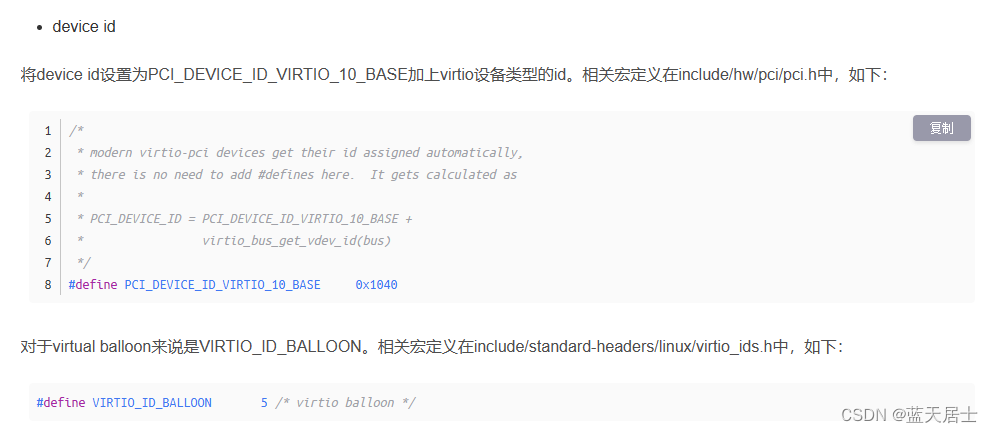
所以,这里virtio设备的device ID(mdev->id.device)就是0x1040+5-0x1040=5,也就代表了VIRTIO_ID_BALLOON。
Vendor ID和Device ID参考笔者的文章: 《PCI Express体系结构导读》随记 —— 第I篇 第2章 PCI总线的桥与配置(12)
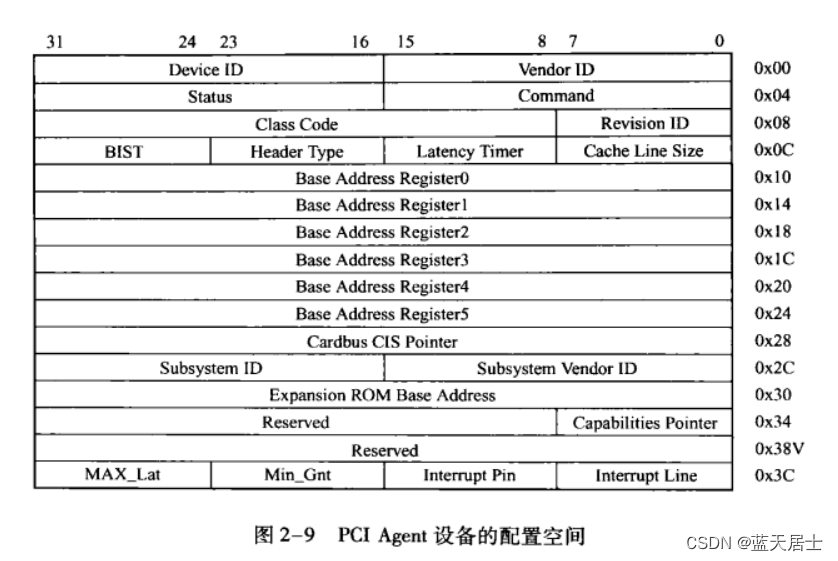
(2)接下来,调用多次virtio_pci_find_capability函数来发现virtio PCI代理设备的pci capability。代码片段如下:
- /* check for a common config: if not, use legacy mode (bar 0). */
- common = virtio_pci_find_capability(pci_dev, VIRTIO_PCI_CAP_COMMON_CFG,
- IORESOURCE_IO | IORESOURCE_MEM,
- &mdev->modern_bars);
- if (!common) {
- dev_info(&pci_dev->dev,
- "virtio_pci: leaving for legacy driver\n");
- return -ENODEV;
- }
-
- /* If common is there, these should be too... */
- isr = virtio_pci_find_capability(pci_dev, VIRTIO_PCI_CAP_ISR_CFG,
- IORESOURCE_IO | IORESOURCE_MEM,
- &mdev->modern_bars);
- notify = virtio_pci_find_capability(pci_dev, VIRTIO_PCI_CAP_NOTIFY_CFG,
- IORESOURCE_IO | IORESOURCE_MEM,
- &mdev->modern_bars);
- if (!isr || !notify) {
- dev_err(&pci_dev->dev,
- "virtio_pci: missing capabilities %i/%i/%i\n",
- common, isr, notify);
- return -EINVAL;
- }
-
- err = dma_set_mask_and_coherent(&pci_dev->dev, DMA_BIT_MASK(64));
- if (err)
- err = dma_set_mask_and_coherent(&pci_dev->dev,
- DMA_BIT_MASK(32));
- if (err)
- dev_warn(&pci_dev->dev, "Failed to enable 64-bit or 32-bit DMA. Trying to continue, but this might not work.\n");
-
- /* Device capability is only mandatory for devices that have
- * device-specific configuration.
- */
- device = virtio_pci_find_capability(pci_dev, VIRTIO_PCI_CAP_DEVICE_CFG,
- IORESOURCE_IO | IORESOURCE_MEM,
- &mdev->modern_bars);
这也是在(QEMU源码)virtio_pci_device_plugged函数中写入到virtio PCI代理设备的配置空间中的,参见 QEMU源码全解析 —— virtio(14) 和 QEMU源码全解析 —— virtio(15) 。
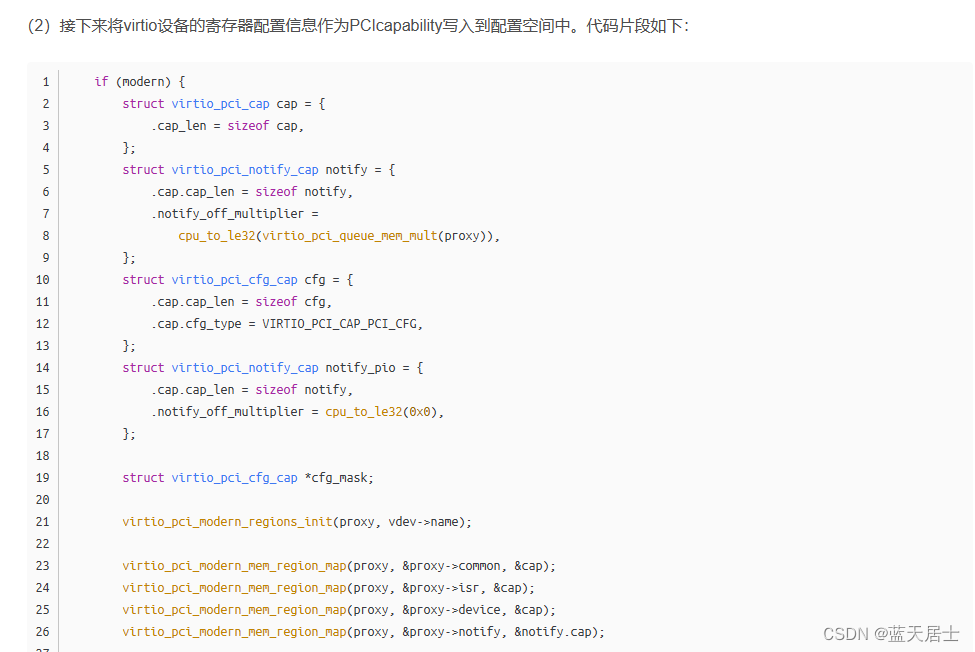
关于pci capability这一部分的PCI知识,参考:
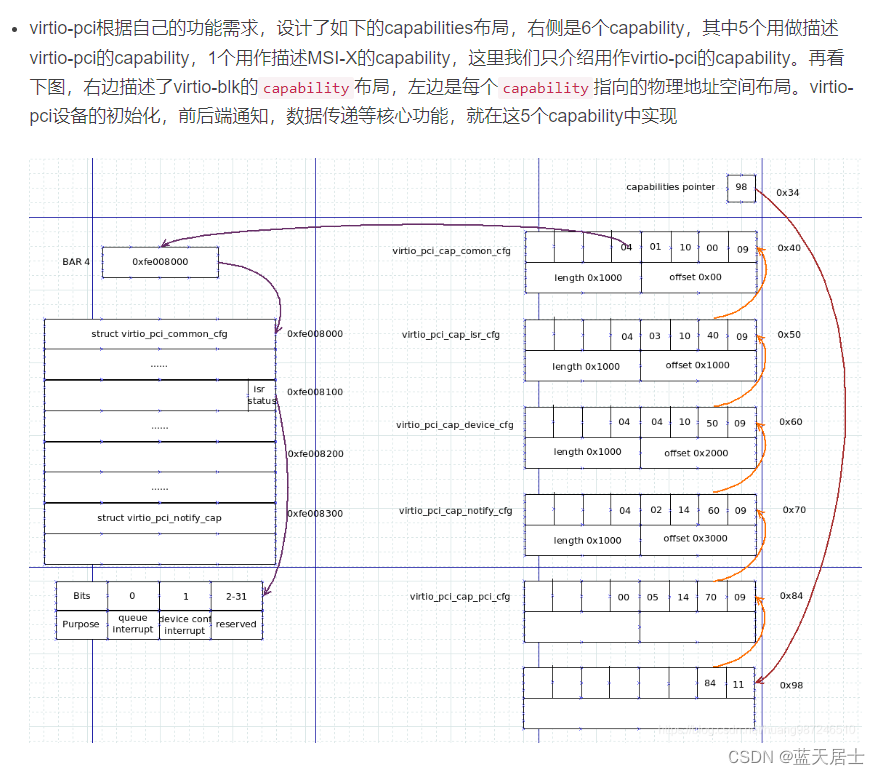
(3)virtio_pci_find_capability函数找到所属的PCI BAR,然后写入到virt_pci_device的modern_bars成员中。代码片段如下:
- /* Device capability is only mandatory for devices that have
- * device-specific configuration.
- */
- device = virtio_pci_find_capability(pci_dev, VIRTIO_PCI_CAP_DEVICE_CFG,
- IORESOURCE_IO | IORESOURCE_MEM,
- &mdev->modern_bars);
从(QEMU源码)virtio_pci_realize函数中可以知道这个modern_bars是1<<4,如下图所示:
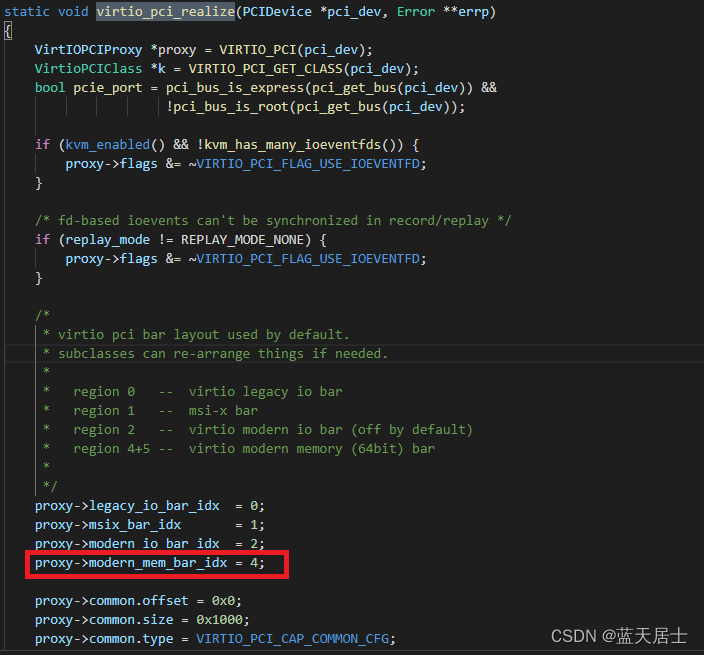
(4)接着,pci_request_selected_regions函数就将virtio PCI代理设备的BAR地址空间保留出来了。代码片段如下:
- err = pci_request_selected_regions(pci_dev, mdev->modern_bars,
- "virtio-pci-modern");
- if (err)
- return err;
(5)调用vp_modern_map_capability函数将对应的capability在PCI代理设备中的BAR空间映射到内核地址空间。代码片段如下:
- err = -EINVAL;
- mdev->common = vp_modern_map_capability(mdev, common,
- sizeof(struct virtio_pci_common_cfg), 4,
- 0, sizeof(struct virtio_pci_common_cfg),
- NULL, NULL);
- if (!mdev->common)
- goto err_map_common;
- mdev->isr = vp_modern_map_capability(mdev, isr, sizeof(u8), 1,
- 0, 1,
- NULL, NULL);
- if (!mdev->isr)
- goto err_map_isr;
-
- /* Read notify_off_multiplier from config space. */
- pci_read_config_dword(pci_dev,
- notify + offsetof(struct virtio_pci_notify_cap,
- notify_off_multiplier),
- &mdev->notify_offset_multiplier);
- /* Read notify length and offset from config space. */
- pci_read_config_dword(pci_dev,
- notify + offsetof(struct virtio_pci_notify_cap,
- cap.length),
- ¬ify_length);
-
- pci_read_config_dword(pci_dev,
- notify + offsetof(struct virtio_pci_notify_cap,
- cap.offset),
- ¬ify_offset);
-
- /* We don't know how many VQs we'll map, ahead of the time.
- * If notify length is small, map it all now.
- * Otherwise, map each VQ individually later.
- */
- if ((u64)notify_length + (notify_offset % PAGE_SIZE) <= PAGE_SIZE) {
- mdev->notify_base = vp_modern_map_capability(mdev, notify,
- 2, 2,
- 0, notify_length,
- &mdev->notify_len,
- &mdev->notify_pa);
- if (!mdev->notify_base)
- goto err_map_notify;
- } else {
- mdev->notify_map_cap = notify;
- }
-
- /* Again, we don't know how much we should map, but PAGE_SIZE
- * is more than enough for all existing devices.
- */
- if (device) {
- mdev->device = vp_modern_map_capability(mdev, device, 0, 4,
- 0, PAGE_SIZE,
- &mdev->device_len,
- NULL);
- if (!mdev->device)
- goto err_map_device;
- }
如mp_dev(struct virtio_pci_modern_device *mdev = &vp_dev->mdev;)的common成员映射了virtio_pci_common_cfg的数据到内核中。这样,后续就可以直接通过这个内存地址空间来访问common这一capability了,其它的capability(isr、notify、device)也与此类似。
vp_modern_map_capability函数在Linux内核源码/drivers/virtio/virtio_pci_modern_dev.c中,代码如下:
- /*
- * vp_modern_map_capability - map a part of virtio pci capability
- * @mdev: the modern virtio-pci device
- * @off: offset of the capability
- * @minlen: minimal length of the capability
- * @align: align requirement
- * @start: start from the capability
- * @size: map size
- * @len: the length that is actually mapped
- * @pa: physical address of the capability
- *
- * Returns the io address of for the part of the capability
- */
- static void __iomem *
- vp_modern_map_capability(struct virtio_pci_modern_device *mdev, int off,
- size_t minlen, u32 align, u32 start, u32 size,
- size_t *len, resource_size_t *pa)
- {
- struct pci_dev *dev = mdev->pci_dev;
- u8 bar;
- u32 offset, length;
- void __iomem *p;
-
- pci_read_config_byte(dev, off + offsetof(struct virtio_pci_cap,
- bar),
- &bar);
- pci_read_config_dword(dev, off + offsetof(struct virtio_pci_cap, offset),
- &offset);
- pci_read_config_dword(dev, off + offsetof(struct virtio_pci_cap, length),
- &length);
-
- /* Check if the BAR may have changed since we requested the region. */
- if (bar >= PCI_STD_NUM_BARS || !(mdev->modern_bars & (1 << bar))) {
- dev_err(&dev->dev,
- "virtio_pci: bar unexpectedly changed to %u\n", bar);
- return NULL;
- }
-
- if (length <= start) {
- dev_err(&dev->dev,
- "virtio_pci: bad capability len %u (>%u expected)\n",
- length, start);
- return NULL;
- }
-
- if (length - start < minlen) {
- dev_err(&dev->dev,
- "virtio_pci: bad capability len %u (>=%zu expected)\n",
- length, minlen);
- return NULL;
- }
-
- length -= start;
-
- if (start + offset < offset) {
- dev_err(&dev->dev,
- "virtio_pci: map wrap-around %u+%u\n",
- start, offset);
- return NULL;
- }
-
- offset += start;
-
- if (offset & (align - 1)) {
- dev_err(&dev->dev,
- "virtio_pci: offset %u not aligned to %u\n",
- offset, align);
- return NULL;
- }
-
- if (length > size)
- length = size;
-
- if (len)
- *len = length;
-
- if (minlen + offset < minlen ||
- minlen + offset > pci_resource_len(dev, bar)) {
- dev_err(&dev->dev,
- "virtio_pci: map virtio %zu@%u "
- "out of range on bar %i length %lu\n",
- minlen, offset,
- bar, (unsigned long)pci_resource_len(dev, bar));
- return NULL;
- }
-
- p = pci_iomap_range(dev, bar, offset, length);
- if (!p)
- dev_err(&dev->dev,
- "virtio_pci: unable to map virtio %u@%u on bar %i\n",
- length, offset, bar);
- else if (pa)
- *pa = pci_resource_start(dev, bar) + offset;
-
- return p;
- }
这样实际上就将virtio PCI代理设备的BAR映射到 虚拟机 内核地址空间了,后续直接访问这些地址即可实现对virtio PCI代理设备的配置和控制。
回到virtio_pci_modern_probe函数。
- /* the PCI probing function */
- int virtio_pci_modern_probe(struct virtio_pci_device *vp_dev)
- {
- struct virtio_pci_modern_device *mdev = &vp_dev->mdev;
- struct pci_dev *pci_dev = vp_dev->pci_dev;
- int err;
-
- mdev->pci_dev = pci_dev;
-
- err = vp_modern_probe(mdev);
- if (err)
- return err;
-
- if (mdev->device)
- vp_dev->vdev.config = &virtio_pci_config_ops;
- else
- vp_dev->vdev.config = &virtio_pci_config_nodev_ops;
-
- vp_dev->config_vector = vp_config_vector;
- vp_dev->setup_vq = setup_vq;
- vp_dev->del_vq = del_vq;
- vp_dev->isr = mdev->isr;
- vp_dev->vdev.id = mdev->id;
-
- return 0;
- }
在调用完vp_modern_probe函数之后,virtio_pci_modern_probe函数接着设置virtio_pci_device中virtio_device的成员vdev的config成员。如果有device这一capability,则设置为virtio_pci_config_ops,否则设置为virtio_pci_config_nodev_ops。
之后设置vpdev即struct virtio_pci_device的几个回调函数:config_vector与MSI中断有关,设置为vp_config_vector;setup_vq用来配置virtio设备virt queue,设置为setup_vq;del_vq用来删除virt queue,设置为del_vq。
至此,virtio_pci_modern_probe函数就解析完了。
欲知后事如何,且看下回分解。










 本文详细解析了Linux内核中virtio_pci_modern_probe和virtio_pci_legacy_probe函数,重点讨论了virtio_pci_modern_probe的执行流程,包括设置virtio设备的vendor ID和device ID,发现PCI capability,映射BAR到内核地址空间等关键步骤。同时,简要介绍了virtio_pci_legacy_probe。通过对这两个函数的解析,加深了对QEMU中virtio设备初始化的理解。
本文详细解析了Linux内核中virtio_pci_modern_probe和virtio_pci_legacy_probe函数,重点讨论了virtio_pci_modern_probe的执行流程,包括设置virtio设备的vendor ID和device ID,发现PCI capability,映射BAR到内核地址空间等关键步骤。同时,简要介绍了virtio_pci_legacy_probe。通过对这两个函数的解析,加深了对QEMU中virtio设备初始化的理解。



